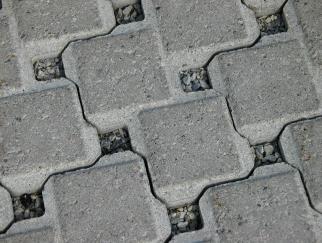Permeable Pavement
 Building parking lots, driveways and roads using permeable pavement helps to restore natural infiltration functions to the landscape and reduce impacts to watercourses by allowing rainwater to slowly infiltrate into the ground. Contaminants are removed from the stormwater as it infiltrates slowly through the gravel sub-base and into the native soil.
Building parking lots, driveways and roads using permeable pavement helps to restore natural infiltration functions to the landscape and reduce impacts to watercourses by allowing rainwater to slowly infiltrate into the ground. Contaminants are removed from the stormwater as it infiltrates slowly through the gravel sub-base and into the native soil.
A variety of different types of permeable pavements are available. These are typically categorized into three main types;
- Modular Interlocking Concrete Block Pavement consists of impervious concrete blocks that allow water to infiltrate into a reservoir through inter-block or intra-block voids. These voids may be filled with gravel or soil and grass. Gravel is the most common filler as it is less susceptible to clogging.
- Porous Asphalt or Porous Concrete consists of standard asphalt or concrete mixes from which the finer aggregates have been removed. Removal of these fine materials results in a pavement with a matrix of pores that allows water to permeate through the surface.
- Plastic Grid Systems consist of plastic interlocking units with virtually no impervious surface area. Grid spaces may be planted with grass or left unplanted and filled with gravel. The grids provide structural stability and prevent settling while allowing a large amount of void space for infiltration of stormwater.
The main environmental benefits of permeable pavements are:
- reduction of runoff, which reduces flood risk, stream erosion and damage to downstream infrastructure;
- removal of contaminants from infiltrated stormwater; and
- reduction in heat flux from the pavement surface to the atmosphere, which helps to mitigate against the urban heat island.
While the runoff reduction benefits of permeable pavements have been widely acknowledged, the heat island mitigation benefits require further study, and are strongly dependent on the type of permeable pavement installed. In general, permeable pavements with a greater vegetated surface area allow for more evapotranspiration and, as a result, a cooler pavement surface.
Inspection and Maintenance Best Practices for Permeable Pavements:
